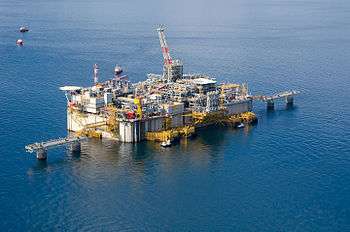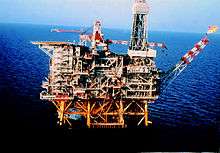Edison (company)
Edison S.p.A is an Italian electric utility company headquartered in Milan. The company was established in 1884 and acquired by Electricité de France in 2012. Edison employs more than 5,000 people in Europe, North Africa and the Middle East. Chairman of the board is Jean-Bernard Lévy (CEO of EDF) and chief executive officer is Bruno Lescoeur.
_logo.svg.png) | |
Edison's headquarter | |
| Public | |
| ISIN | IT0003372205 |
| Industry | Energy industry |
| Founded | 1884 |
| Headquarters | , |
Key people | Bruno Lescoeur (CEO) Jean-Bernard Lévy (Chairman) |
| Products | Natural gas Electric power |
| Revenue | €9.159 billion (2018)[1] |
| €793 million (2018)[1] | |
| €199 million (2018)[1] | |
| Total assets | €6.557 million (2018)[1] |
| Total equity | €6.141 million (2018)[1] |
Number of employees | 5,372 (2018) |
| Parent | Électricité de France (99.4%) |
| Website | www |
History
Early history (1884-1966)
Founded in 1884 by Giuseppe Colombo in Milan, Italy, as "Società generale italiana di elettricità sistema Edison", it served the purpose of introducing and applying Thomas Edison's inventions to Italy. Indeed, Colombo, an engineering professor, was a great admirer of Edison, whom he had met in the United States in 1881, securing an exclusive licence for some of his patents for Italy and hiring some of his collaborators.[2] Edison operated Santa Radegonda power plant, Europe's first power plant.[3] In the following decades Edison continued growing, especially in hydroelectric power, and came to control power distribution in most of northern Italy. In 1962 the centre-left coalition government of Christian Democrats and Socialists decided the nationalisation of the electric sector in Italy, in order to break the oligopolistic power of the four dominant electric companies that then dominated all the national market.[4] With the compensation money it obtained from the state, Edison, then headed by Giorgio Valerio, invested heavily to diversify its activities, primarily in the petrochemical sector and by buying Standa supermarkets chain, continuing producing power only for self-consumption.[5] However, this strategy was unsuccessful, as competition with both state-owned Enrico Mattei's giant Eni and Montecatini, a large private chemical company, proved too hard, so in 1965 Edison was eventually forced to merge with Montecatini, forming Montedison, the largest chemical company in the country.[6]
Montedison era (1966-2001)
Montedison initially was doing well, dominating about 80% of the national chemical market and 15% of the European Community market. However, the 1973 oil crisis proved disastrous for the company that was forced to seek state intervention in order to avoid bankruptcy; by the mid 1970s the Italian state came to own about 17% of Montedison, becoming its largest single shareholder, but its effective control was even greater as state-owned banks held shares. The company became increasingly an arm of sate social policy and employment goals were favored over profits.[7]
In 1980 Mario Schimberni became chairman and negotiated the sale of the state-owned shares to Gemina, a consortium of banks and private companies, in order to free Montedison from government interference. Through a rigorous cost-cutting plan and joint-ventures with Mitsui and Hercules Inc. Schimberni transformed the money-losing manufacturer of commodity chemicals and plastics into a profitable diversified holding company.[8]
In 1985 Raul Gardini, an agri-business tycoon, started buying into Montedison, and by 1987 he came to own 40 per cent of the company's shares, thus taking over the company and forcing Schimberni to leave. Gardini wanted to reorganize and integrate the company into his sugar and fertilizer empire, but the debt burden he incurred during the takeover rapidly brought Montedison on the threshold of bankruptcy, forcing Gardini to seek state aid. In 1988 a new joint-venture was formed with Eni, called Enimont, in which both companies had 40 per cent of the shares, while 20 per cent was sold on the market. In 1990 Eni bought all Montedison's shares in Enimont, and Montedison withdrew from the chemical sector to pursue a role as an energy company.[9]
In 1991 Montedison revived the name Edison to rebrand SELM, a spin-off company in which all its energy assets had been put in 1978.[10] In 1999, the Bersani decree liberalized the Italian energy market and reintroduced competition in the electric market, and later the Letta decree opened up the natural gas market, allowing Edison to begin supplying electricity to eligible customers and expanding its downstream presence in the natural gas sector.[11]
As Edison S.p.A. (2002-present)
In 2001 a successful hostile bid to acquire Montedison (that controlled Edison as a subsidiary) was launched by Italenergia S.p.A., a consortium set up by Fiat, Electricité de France, Sanpaolo IMI, Banca Intesa and other investors. Following the takeover, Montedison was reorganized by selling all its non-energy assets. In 2002 Montedison was merged with Edison, Sondel and Fiat Energia under the name of Edison S.p.A. In 2005, Transalpina di Energia, a consortium set up by Electricité de France and A2A, purchased 63.3% of the common shares of Edison from Italenergia. In 2012, Electricité de France finally bought 99.5% of Edison's shares and delisted it from Milan stock exchange.[12]
Operations


Edison's primary activities are production and distribution of electricity and natural gas. Edison and its subsidiaries operate across Europe, Africa, and the Middle East.[13][14][15]
Edison is the second largest power producer in Italy (about 15% of national output) and in Greece (about 12% of national output).[13] It operates in Greece through subsidiary Elpedison (38% interest, a joint venture between Edison, Hellenic Petroleum and Ellaktor.[16] Together with DEPA, it develops the Greece–Italy pipeline project.[17]
Hydrocarbons operations include exploration, production and distribution of natural gas and crude oil. As of 2010, Edison owned 80 hydrocarbons concessions and permits with hydrocarbons reserves of 52.8 billion cubic metres (1.86 trillion cubic feet).[18]
Financial Results
| In million € | 2014 | 2013 | 2012 | 2011 | 2010 | 2009 | 2008 |
|---|---|---|---|---|---|---|---|
| Gross revenue | 12,325 | 12,335 | 12,014 | 12,097 | 10,446 | 8,867 | 10,064 |
| EBITDA | 814 | 1,009 | 1,103 | 1,003 | 1,369 | 1,471 | 1,643 |
| Net revenue | 40 | 96 | 81 | 871 | 21 | 240 | 346 |
Shareholders
The Company's controlling shareholder is Electricité de France with 99.4% of the capital.[23][15]
Corporate Whistleblowing
On July 19, 2016 the company launched a whistleblowing platform available to its employees in order to collect information about wrongdoing and fight internal corruption.[24][25]
References
- "Economic and financial figures". Retrieved 3 February 2020.
- Freni, Giuseppe; Kurz, Heinz D.; Lavezzi, Mario; Signorino, Rodolfo (2016). Economic theory and its history. Routledge. pp. 406–407. ISBN 9781138186590.
- Dyer, Frank Louis; Martin, Thomas Commerford (2001). Edison : his life and inventions. University Press of the Pacific. p. 283. ISBN 0898756707.
- Ginzburg, Paul (1990). A History of Contemporary Italy: 1943-80. Penguin Books. pp. Chapter 8. ISBN 9780141931678.
- "Montedison S.p.A. - Company Profile, Information, Business Description, History, Background Information on Montedison S.p.A." www.referenceforbusiness.com. Retrieved 25 October 2017.
- McCarthy, Patrick (1997). The crisis of the Italian state : from the origins of the Cold War to the fall of Berlusconi and beyond. New York: St. Martin's Press. p. 85. ISBN 0312163592.
- Moss Kanter, Rosabeth; Stein, Barry A.; Jick, Todd D. (1992). The Challenge of organizational change : how companies experience it and leaders guide it. New York: Free Press, a division of Simon & Schuster Inc. p. 255. ISBN 0743254465.
- Moss Kanter, Rosabeth; Stein, Barry A.; Jick, Todd D. (1992). The Challenge of organizational change : how companies experience it and leaders guide it. New York: Free Press, a division of Simon & Schuster Inc. pp. 257–267. ISBN 0743254465.
- Dunford, Michael; Greco, Lidia (2006). After the Three Italies: Wealth, Inequality and Industrial Change (Chapter 9). Hoboken, New Jersey: Blackwell Publishing. pp. 245–281. ISBN 978-1-405-12520-8.
- "Montedison now set on more practical, less grandiose course". Independent Chemical Information Service. 7 July 1991. Retrieved 4 February 2020.
- Monti, Nicola. "From Letta and Bersani Decrees to the Future Challenges. The Role of Edison". link.springer.com. Retrieved 3 February 2020.
- Raj, Chari (2015). Life After Privatization. Oxford University Press. p. 170. ISBN 9780199658312.
- "Who'S Who Sutter'S International Red Series". Retrieved 25 October 2017.
- "Fact sheet on Edison's activities in the hydrocarbons sector". Archived from the original on 2014-07-14. Retrieved 25 October 2017.
- "Quote Not Found - Wall Street Journal". quotes.wsj.com. Retrieved 25 October 2017.
- "Who we are". Edison. Retrieved 25 April 2013.
- "Interconnection Turkey Greece Italy (ITGI) Pipeline - Hydrocarbons Technology". Retrieved 25 October 2017.
- "Hydrocarbons business" (PDF). Edison. Retrieved 25 April 2013.
- http://www.edison.it/financial_statement_2011/attachments/it/Bilancio_Annuale_2011.pdf%5B%5D
- "Edison: utile netto 2013 sale a 96 milioni di euro". Firstonline. Retrieved 25 October 2017.
- "Highlights". Archived from the original on 2016-03-24. Retrieved 25 October 2017.
- "Archivi dei bilanci e delle relazioni infra-annuali – Edison". Archived from the original on 4 March 2016. Retrieved 25 October 2017.
- "Capitale e azionariato - Edison". Archived from the original on 2014-04-24. Retrieved 25 October 2017.
- "Announcement of the whistleblowing platform". Edison. Retrieved 23 July 2016.
- "Policy Whistleblowing Edison" (PDF). Edison. Archived from the original (PDF) on 2016-08-11. Retrieved 23 July 2016.